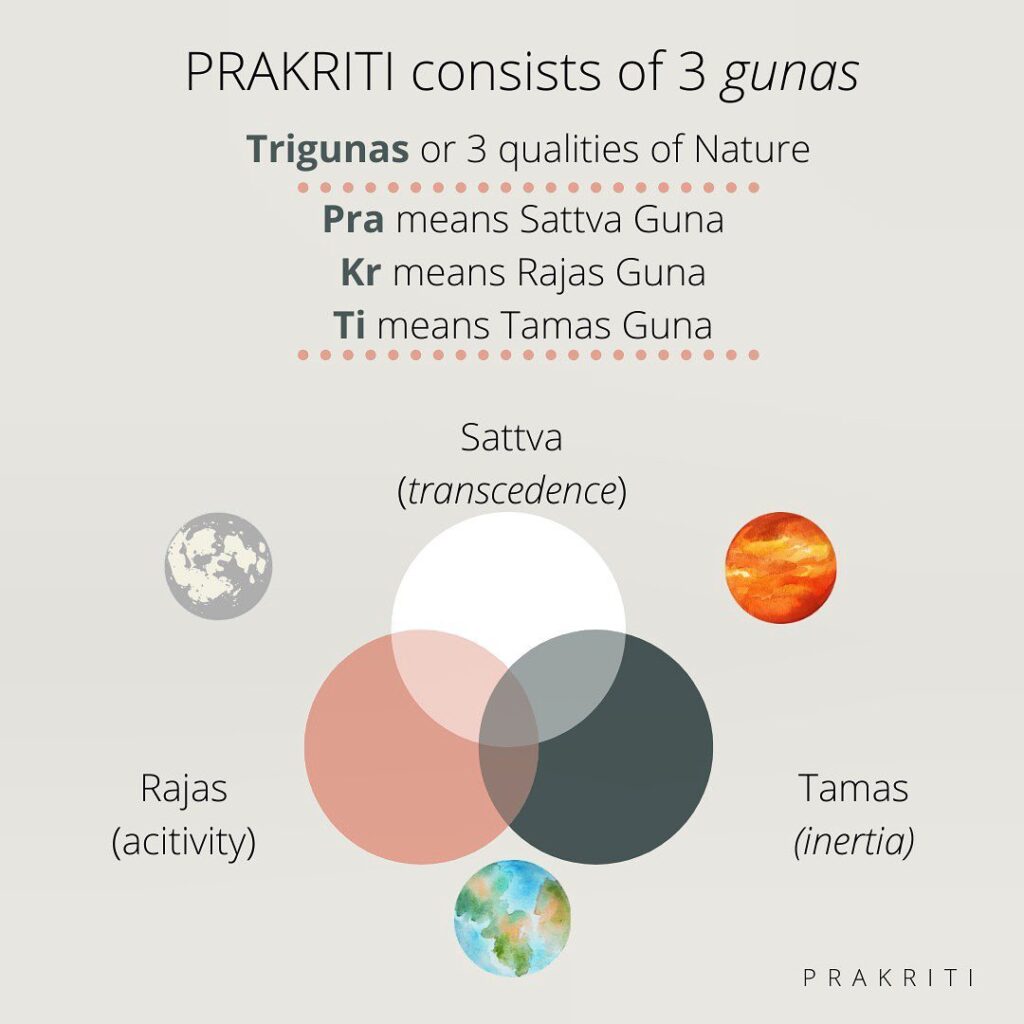Guṇas / Triguṇas II

“I will reveal you now the transcendental knowledge, the highest science which knowledge has led all wise men from this world to the Supreme Spiritual Perfection. Laying their foundation on this knowledge, they became the same with me; they will not be born even at the beginning of a new cycle of creation, and they have no fear at its dissolution.”
Thus starts Krishna in Bhagavadgītā the explanations referring to the deep knowledge of the three Guṇa. We can infer from this how important the understanding of the action of these 3 Guṇa or tendencies is. All fundamental yogic texts about the creation of the world or about the modalities of evolution for the human beings – and always existed an analogy between the cosmic processes of creation, maintenance and dissolution of the world and the stages which a human being must pass through to reach the supreme state of wisdom – are speaking about Guṇa and consider them to be the fundamental elements that serve as a basis for the understanding and explanation of deep truths. For this reason it is necessary that every yogi must be preoccupied with the understanding of the three Guṇa which will offer him the keys to understand the nature as a close or far away (sources of cosmic energy from Universe) environment. The one who understands the play of the three Guṇa that takes place permanently in Universe can define exactly the cause and the nature of any thought, intention, force, action in manifestation, and the modalities through which all these can be transcended to reach the supreme state of liberty in which is achieved the fusion with the DIVINE and in which the cosmic cycles of creation and dissolution cannot affect him.
The Three Guṇas are Sattva, Rajas and Tamas. The three Guṇas are qualities of Prakṛti, of everything that has been created, and thus they are the inherent characteristic of all matter and energy. They form everything that has been created. Everything that has been created contains different proportions of these three Guṇa.
The Guṇa are representing the basic qualities of the nature. The great sages of the East have discovered in nature three components. This idea of the three types (Guṇa) is the result of a long term psychological research and of a deep inner experience.
In the yogic conception there are two eternal principles: Pūruṣa – The spiritual principle of consciousness – energy, and Prakṛti – the unconscious, material – energy principle. Prakṛti represents the subtle, none manifested, intangible origin of that which becomes later the physical matter. Its attributes are in fact these three Guṇa.
1. SATTVA is the force of the equilibrium and includes goodness, harmony, happiness, lightness, purity. It produces liberty and refined pleasure.
2. RAJAS is the force of the movement and includes activity, energy, effort and passion. It produces pain, restlessness and fight.
3. TAMAS is the force of inertness and includes obscurity, ignorance, inability, powerlessness, unconsciousness. It produces degradation, degeneration and larvarity.
You can find many different attributes to these three Guṇas, but here is the basic definition:
- Sattva is Vishnu, the Maintainer, and his shakti
- Rajas is Brahma, the Creator, and his shakti
- Tamas is Rudra, the Destroyer or Dissolver, and his shakti.
- Sattva is manifestation or revelation
- Rajas is action, the dynamic aspect
- Tamas is veiling, and resisting
- Sattva is action
- Rajas is desire
- Tamas is knowledge
- Sattva is essence
- Rajas is movement
- Tamas is inertia
These three Guṇas or qualities mix together in different proportions and create the different life forms of devas, man, animal, plants, minerals and matter.
THE THREE Guṇas AND THE FIVE ELEMENTS:
The Puruṣa is a homogenous entity composed of pure consciousness that serves as the seer and witness behind the processes of nature, which function through its presence. Prakṛti or Nature, however, is a heterogeneous substance with diverse actions. It is composed of the three Guṇas or prime qualities of sattva (balance and intelligence) rajas (action and energy) and tamas (inertia or materiality) and their ever-changing permutations and interactions.
The Guṇas are the primordial forces behind cosmic evolution, which proceeds from matter (tamas) to life (rajas) and mind (sattva). Only from the level of pure sattva (the clarity of the higher mind) can we have an enduring access to the Purusha or higher Self, whose nature is extremely subtle. For this reason, both Yoga and Ayurveda emphasize the cultivation of sattva Guṇa. Marmas can be used to balance our Prāṇa or vital energy and increase sattva.
From the combination of the three gunas arises the five great elements (Pañcamahābhūta) of earth, water, fire, air and ether—the solid, liquid, radiant, gaseous and etheric forms of matter—which are central to both yogic and Ayurvedic thought. The elements show that the entire universe consists of different frequencies or vibrations of the same underlying substance (Prakṛti), justas water can be found in solid, liquid and gaseous forms.
From these five great elements the three biological humors or doshas arise—the main factors of Ayurvedic thought. The doshas are the underlying energetic forces behind the workings of both body and mind. They represent the five elements imbued with the life-force (Prāṇa). Each dosha consists of two of the five great elements as well as a portion of the three gunas.
| ELEMENT | GUNA | DOSHA |
| Space – Sound | Sattva | Vata |
| Air | Rajas | Vata |
| Fire | Sattva + Rajas | Pitta |
| Water | Sattva + Tamas | Kapha + Pitta |
| Earth | Tamas | Kapha |
In this scheme, the subtle elements of air and ether (Vata dosha) control the gross elements of earth, water and fire (Kapha and Pitta doshas). Most marmas are located near joints and orifices that contain space and hold air or energy. Marmas are important centers that govern the air and ether elements in the body and therefore can be used to control the elements in the body as a whole.
| Τάσεις/αρχές | Αιτία – καταστασεις | Αποτελέσματα |
|---|---|---|
| SATTVA | Αρετή (σταθερό, στοχεύσει στις ενέργειές για ιδανικό αγαθό και ομορφιά, εσωτερική τελειότητα, αγνότητα) Ανώτερη γνώση Αποστασιωποιηση, αποδσμευση, αυταπάρνηση Δύναμη (κυριαρχια μιας γιγαντιαίας ενέργειας), δύναμη – σε πλήρη πόλωση (+) και (-) | Ανύψωση, πρός τα πάνω-που πηγαίνει προς τους πνευματικούς, θαυμάσιους κόσμους των Θεών. Εξέλιξη. Η διακοπή της ενσάρκωσης στον επίγειο κόσμο. Απελευθέρωση από τον κύκλο των αναγεννήσεων, ο οποίος παραχωρεί την ελευθερία. Επανάληψη στην αρχέγονη Macrocosmic πραγματικότητα, άπειρη δύναμη, πλήρης αρμονία, αλάθητο. Εξαφάνιση των εμποδίων, ακύρωση των δυσκολιών, αβίαστη ανάπτυξη των εξαιρετικών δυνάμεων (siddhi – s), επιτυχία. |
| RAJA | Εξαπολυμένο πάθος το οποίο υποτάσσει και εξουσιάζει το μετασχηματισμό | Μετενσάρκωση, μετακίνηση μέχρι την επίτευξη του Διαφωτισμού που θα σπάσει τις αλυσίδες της επιθυμίας. |
| TAMAS | Έλλειψη αρετής (κακία, ακαταμάχητη ώθηση για να διαπράξει τις κακές πράξεις, σκοτεινό πάθος, ακαθαρσία) Aγνοια, ηλιθιότητα, έλλειψη κατανόησης Μη-εγκατάλειψη, σύνδεση Αδυναμία, αδυναμία, αδυναμία | Involution (κάθοδος) πτώση, προς τα κάτω-μετάβαση, πτώση, που γλιστρά στην κατωτερότητα. Προκήρυξη εμποδίων στην πλήρη δύναμη. Νωθρότητα, τεμπελιά, παθητική παράδοση σε όλο το είδος χαμηλότερων ενεργειών. Μιμητικη ύπαρξη, που ρυθμίζεται από τις κοινωνικές συμβάσεις. Ανικανότητα της αντίθεσης, που επιτρέπει σε μια προφανή μοίρα. Δουλεία, μειωμένη δύναμη, πρόβλημα, δυσαρμονία. Possessiveness. Εφήμερη ικανοποίηση. Πόνος. Δαιμονική κατοχή. Εγωισμός. Δυσκολίες, αποτυχssα, εμπόδια των επιθυμιών στην πραγματοποιηση. Έλλειψη επιτυχίας. |
“That which does not exist cannot come into being, that which exists will exist forever.”
~Bhagavadgītā II, 16
QUALITIES OF FOOD / Guṇas
As we mentioned at the classes on the FIRST TRIMESTER of the Study course, in nature we have 3 qualities of energy Guṇa / Triguṇa: “quality, peculiarity, attribute, property”. These three Guṇas are called: sattva (goodness, calmness, harmonious), rajas (passion, activity, movement), and tamas (ignorance, inertia, laziness). All of these three guṇas are present in everyone and everything, it is the proportion that is different, according to Hindu worldview. The interplay of these guṇas defines the character of someone or something, of nature and determines the progress of life.
The entire human activity, the way in which a man feels, acts, lives and thoughts are conditioned by food. The Upaniṣads too state that the mind depends on food:
“The food we eat transforms gradually on three different ways: the grossest part of it is eliminated. The medium density part is transformed into flesh and the subtlest part feeds the mind.”
~Chāndogyopaniṣad VI, V, 1
In Bhagavadgītā it is mentioned that the three types of temperament (SATTVA, RAJAS and TAMAS) are related with several types of foods which we eat:
“The foods which enhance life, strength, happiness and joy, which are tasty, contain oil, does not rot and are pleasant are preferred by the SATTVIC being”.
~Bhagavadgītā
“Bitter, sour, too salty, too hot, pungent, tasteless, burning foods which are pleasant to the RAJASIC being bring misery, suffering and disease. Rotten, bad smelling, remaining from the others, thus are the foods which are pleasant to the TAMASIC beings.”
~Bhagavadgītā
The food has an intimate and direct relationship with the mind and it plays an important role in the perfection of a being. The diet of a yogi must be essentially SATTVIC: cereals (wheat, rice, barley, buckwheat, millet etc.), ghee, milk, cheese, honey, ripped fruits (grapes, oranges, bananas, apples, dates, and figs), nuts, almonds, peanuts, pollen, pure rainwater or spring water.
The famous yogi SIVANANDA used to recommend the ginger flour with milk to be a sattvic food used frequently by yogis because it gives energy and refreshes the mind improving the digestion.
The RAJASIC foods are: meat, fish, salt, mustard, vinegar, and acid foods in general, spicy foods, too salty, too astringent, bitter, and sour, the non ripped fruits or the ones excessively ripened. These foods distract and stir up the mind, excite the passions and emotions diminishing the power of will.
Heavy food leads to a TAMASIC state generating somnolence, indulging and laziness. There is a false general view that a great amount of food is crucial for maintaining a good state of health and power. In fact, all depends on the assimilating and absorption power of the living being. That is why the most of the food gets undigested and directly eliminated. The ignorant people eat several times a day without wonder even a single time in their lives about the problem of knowing what a truly balanced diet means. The artificial, man made foods are spreading more and more and the Western people, loosing any sense of the value of a food end themselves in consuming unhealthy food. The food items which are rotten, re-heated or boiled more than 3 hours are TAMAS in nature and are generating several disorders such as: intoxication, constipation, obesity etc. On the other hand, the RAJAS food items create hypertension being unhealthy for kidneys and liver; it satisfies the senses but is unhealthy physically and mentally. It can also intensify the stress states, the internal tensions leading to the occurrence of different psychic disorders. Neither mostly TAMAS food nor mostly RAJAS food are recommended for those who are following a spiritual path. That is why the yogi must carefully select and prepare his food following strictly the rules. However, it is a well known fact that “natural non facit saltum” (the nature does not change through leaps). Thus, we should not take recourse to sudden changes in any direction and especially regarding food.
Food means potential energy. Water feeds the body with energy too, and so the air. We can live without food several days but only a few minutes without air. The energy is the one which supports the body. Certain advanced yogis are replacing the food with subtle nectar. This nectar is not a beverage in the real sense of the word but represents in fact a metaphorical designation of a subtle energy that spreads all over the body feeding it. Such a yogi can extract his energy directly through his pure, irresistible desire maintaining thus the body without any normal food. This represents in fact a transcendence of the actions of GUNAS.
Sattvic Diet:
Ayurveda emphasizes a Sattvic diet for healthful living, particularly for keeping our minds happy and at peace. Sattvic diet was originally devised for the practice of Yoga and the development of higher consciousness. It aids in the treatment of mental disorders because it helps restore harmony and balance (Sattva) to the mind.
Ayurveda recognizes six tastes, each of which is composed of two of the five elements:
Sweet …………………..earth and water
Salty ……………………..water and fire
Sour ……………………..earth and fire
Pungent ………………..fire and air
Bitter ……………………air and ether
Astringent………………earth and air
Sweet is the primary Sattvic taste because it is nurturing and harmonizing, reflecting the energy of love. Pungent, sour and salty tastes are Rajasic (stimulant-irritant) because they activate the senses and make the mind extroverted. Bitter and astringent tastes are Tamasic in the long term because their effect is to deplete the vital fluids.
Sattvic diet can be modified for best effect according to the three biological humors of Vata, Pitta and Kapha. One should follow the diet for one’s constitutional type, emphasizing those articles which are Sattvic and avoiding those who are Rajasic or Tamasic. By combining a diet for increasing Sattva along with one for reducing one’s bio- logical humor, diet becomes a powerful tool for improving health. For specific psychological problems, more specialized diets may be prescribed. (David Frawley)

The limits of the Guṇas
However, the GUNAS are limited because of their finite character and way of action and consequently are producing limitation. TAMAS represents an inability and so it is obvious a limitation. The RAJASIC will represent a more beneficial force initiating things, but we can see pretty good that desire with its limits and compulsions will always be a limitation for man. SATTVA bounds the human being because it is mostly a mental principle, a principle of limited and limitative knowledge, happiness that depends on the acquisition or achievement of a certain limited thing, object or state of the mind, an illumination which is not enough clear. The pleasure generated by SATTVA relates with the transient things, consisting in an ability to integrate in the environment with spontaneous ease mostly because of inborn qualities. SATTVA creates an attachment for happiness, RAJAS for action; TAMAS hides knowledge and attaches itself to negligence, fault and inaction. BHAGAVAD-GITA chapter XIV sutras 6 – 8 states: “SATTVA bounds through attachment towards knowledge and happiness; RAJAS bounds the incarnated spirit through attachment towards action and TAMAS bounds through negligence, indolence and sleep.”
The knowledge is the one which shows us how to act. So it determines the quality of an action and, on a subtler level it could be considered an action in itself.. Happiness represents the fruit of the actions of a human being that obtained a profound knowledge. But both the fruit of an action and the action in itself should never bond us. In BHAGAVAD-GITA Krishna says: “As the ones who doesn’t know are acting in attachment for a certain action, those who know must act without attachment”. “Our actions together with their fruits must be Rendered to God”. In this direction, the attachment for knowledge and happiness can only be a limitation.


